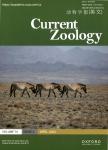Coevolution between Himalayan cuckoos and 2 sympatric Pycnonotidae hosts
作者机构:Ministry of Education Key Laboratory for Ecology of Tropical IslandsKey Laboratory of Tropical Animal and Plant Ecology of Hainan ProvinceCollege of Life SciencesHainan Normal UniversityHaikou571158China Key Laboratory of Beibu Gulf Environment Change and Resources Utilization of Ministry of EducationNanning Normal UniversityNanning530001China Ecologie Systématique EvolutionUniversitéParis-SudCNRSAgroParisTechUniversitéParis-SaclayOrsay CedexF-91405France Ministry of Education Key Laboratory for Biodiversity Science and Ecological EngineeringCollege of Life SciencesBeijing Normal UniversityBeijing100875China
出 版 物:《Current Zoology》 (动物学报(英文版))
年 卷 期:2021年第67卷第6期
页 面:639-644页
核心收录:
学科分类:0710[理学-生物学] 07[理学] 071002[理学-动物学]
基 金:supported by the Hainan Provincial Natural Science Foundation of China(320CXTD437 to C.Y.) the National Natural Science Foundation of China(Nos.31672303 to C.Y.,31772453 and 31970427 to W.L.)
主 题:Cuculus saturatus distance to forest parasitism risk Pycnonotus xanthorrhous Spizixos semitorques
摘 要:Selection due to cuckoo parasitism is responsible for the evolution of anti-parasitism defenses in *** host species breeding sympatrically with a single parasitic cuckoo may evolve different strategies to reduce the risk of counter cuckoo parasitism,resulting in different interactions between cuckoos and hosts in areas of ***,we studied the coevolutionary interactions between Himalayan cuckoos Cuculus saturatus and 2 sympatric and closely related potential hosts belonging to the family Pycnonotidae,the brown-breasted bulbul Pycnonotus xanthorrhous and the collared finchbill Spizixos *** investigated parasitism rates and nest-site selection(nest height,nest cover,human disturbance,perch height,forest distance,and degree of concealment)related to parasitism risk,nest defense against a cuckoo dummy,and egg rejection against cuckoo model *** used specific nest sites that were further away from forests than those of finchbills,and they behaved more aggressively toward cuckoos than *** contrast,bulbuls possessed moderate egg rejection ability,whereas the finchbill rejected 100%of cuckoo model *** suggest that selection of a nest site away from forests by the bulbul explains the absence of parasitism by Himalayan *** suggest that these interspecific differences in nest-site selection and nest defense indicate alternative responses to selection due to cuckoos.



